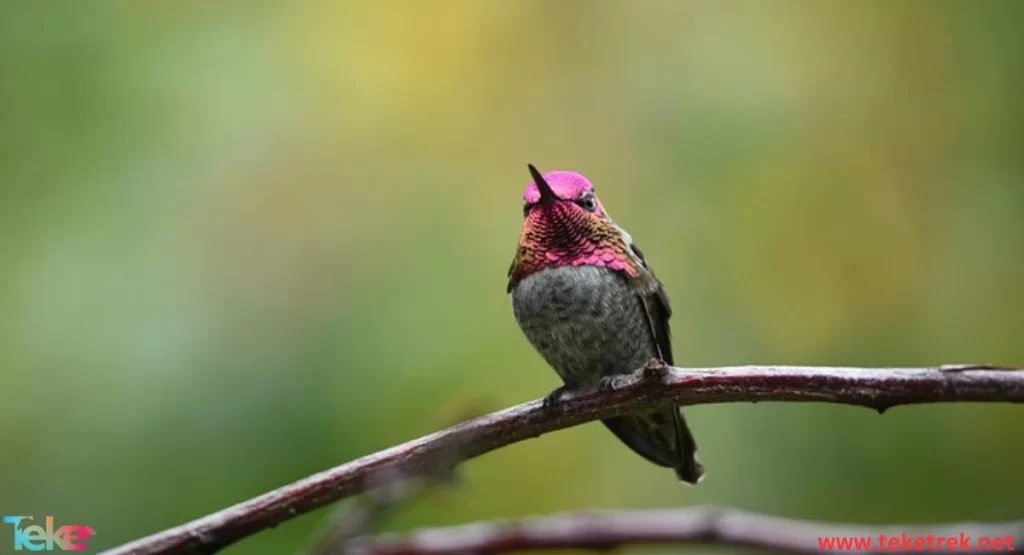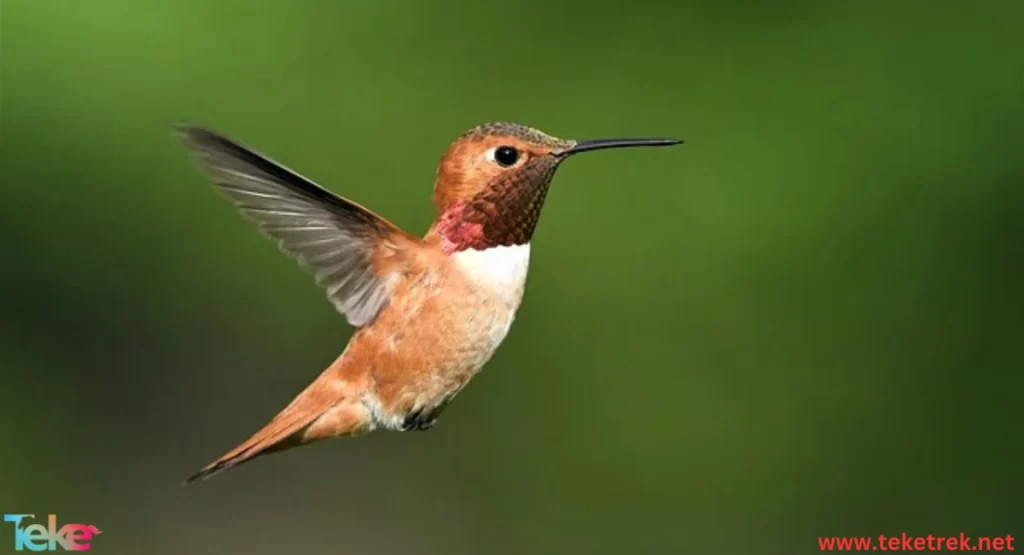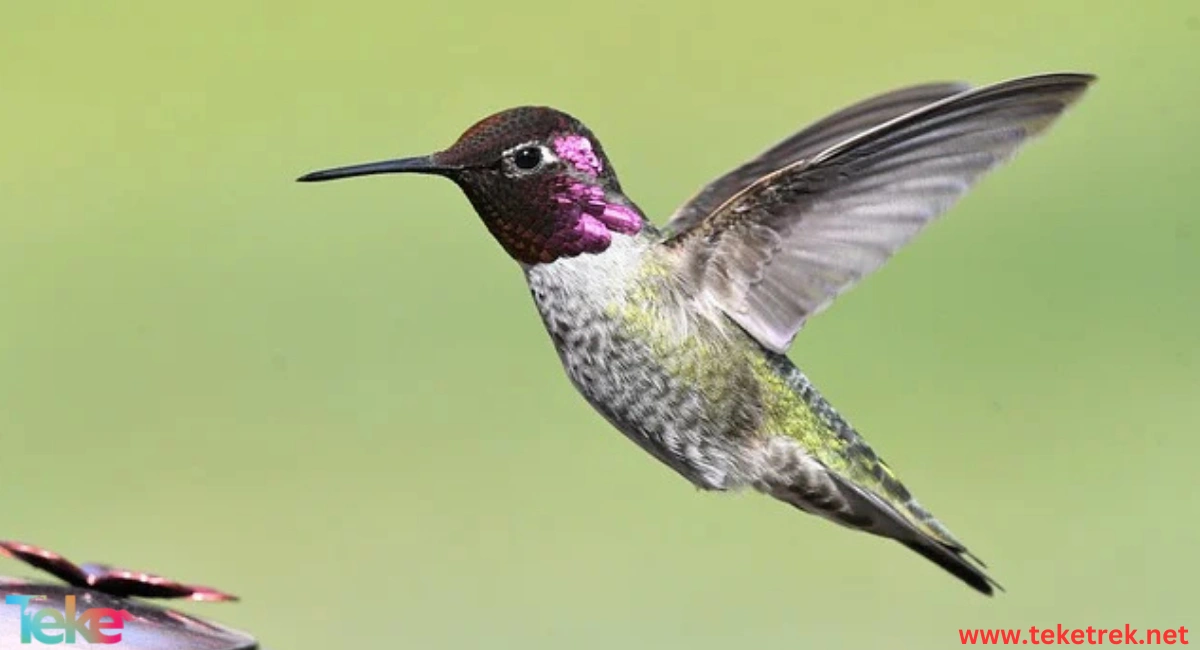The hummingbird is one of the smallest birds on Earth, with over 300 species in its family. One of the most famous is the Ruby-throated Hummingbird, which has iridescent feathers and colorful plumage.
Now that we’ve introduced this remarkable bird, let’s explore its appearance, body, and composition.
In this article in TekeTrek Website, we will introduce you to the most important information related to this object. Follow along with us.

Description of the Hummingbird
- The hummingbird has a compact body and strong muscles, with relatively long and narrow wings resembling blades, unlike the wings of other birds, which are connected to the body only at the shoulders.
- The Hummingbird size ranges from small to medium, typically between 8 and 13 centimeters in length. Their tongues have the ability to extend to help them feed on flower nectar.
- The color of the hummingbird varies by species and geographic distribution. Generally, hummingbirds can have diverse colors, including green, blue, red, yellow, orange, white, and black, as well as mixed colors and decorative patterns on the wings and tail. The colors of hummingbirds also change with the seasons and life stages.
- The tail may vary in shape among different birds, being either long and pointed or short and square, depending on the species.
- Females are larger in size than males, but male colors are generally more vibrant.
- Hummingbirds typically have relatively large eyes, which help them clearly see flowers and nectar.
- They are characterized by their short and weak legs compared to body size, as hummingbirds spend most of their time in the air and rely on flight rather than walking.
- The beak of the hummingbird is often thin and pointed, aiding in probing into flowers and extracting nectar.
Habitat of the Hummingbird
- Hummingbirds exclusively inhabit the continents of North and South America.
- They prefer to live in semi-desert areas and the forested regions surrounding the Amazon River.
- There is a species that lives in Chile in temperate regions.
- Around 340 species of these birds live near the equator, and ten species reside in northern Mexico.
Types of hummingbirds
There are approximately 350 species of hummingbirds. Here are some of them:
1. Bee hummingbird: The smallest species in the hummingbird family, with an average size of about 5 cm.
2. Grey-chinned Hummingbird: It is characterized by gray chest feathers and green feathers on the back.
3. Ruby-colored hummingbird with white neck and gray back: It has a white neck and gray back, with dark red throat feathers in males.
4. Costa’s Hummingbird: Its feathers are bright green and its throat is white.
5. Orange-bellied Hummingbird: The belly feathers are orange with green sides.
6. Broad-winged hummingbird: The underside of the wings is dark brown, the breast is green, the throat is blue, and the beak is red.
7. Lucifer’s Hummingbird: Bright green metallic plumage.
What is the best food for hummingbirds?
- These birds primarily feed on flower nectar because it provides them with the necessary energy and calories needed for flight.
- Hummingbirds obtain proteins from small insects and sap from tree holes, often taken from woodpecker drillings.
- They gather flower nectar using their long, expandable tongues to catch insects while in flight.
- It’s been said that these birds visit anywhere from 500 to 3000 flowers per day to obtain nectar


Reproduction in Hummingbirds
- It’s important for males to perform an enticing dance in front of females, and upon acceptance, the mating process begins.
- Initially, a small, padded nest is built, often constructed from a low-growing shrub.
- The female lays two eggs over two days and incubates them for about two weeks.
- Female hummingbirds feed their chicks for approximately 4 weeks, during which time they visit the nest around 140 times a day to feed the young.
- Many hummingbirds are polygynous, and after mating, they forsake their parental responsibilities.
facts about hummingbirds
- The hummingbird is a wonder in the bird world because while all birds fly forward, it can also fly backward.
- It has the ability to fly vertically with precision, allowing it to reach deep flowers within forests.
- Hummingbirds play a crucial role in plant pollination, transferring nectar and pollen between flowers, contributing to plant reproduction.
- It is considered one of the fastest birds in the world, capable of flying at speeds up to 80 kilometers per hour.
- Wing flapping requires a lot of energy, so hummingbirds rest on branches.
- Hummingbirds fly in the rain and shake their heads to disperse water droplets.
- Hummingbirds have around 15 vertebrae in their necks, while mammals have only 7.
- The heart of a hummingbird is relatively large compared to other animals, constituting 2.5% of its body weight.
- Its tongue is flat, divided at the end, and branched, resembling a feather.
- The lifespan of a hummingbird ranges from less than a year to five years.
- It lays the smallest eggs in the world, weighing about 0.365 grams.
- The iridescent colors of the hummingbird are a distinguishing feature caused by air bubbles in its feathers that break and reflect light.
- During winter and at night, hummingbirds do not eat; they enter a state of torpor, reducing their heart rate to 40 beats per minute instead of 400.
FAQ
- What is the average heart rate of a hummingbird?
The heartbeat of a hummingbird reaches up to 1260 beats per minute during flight.
- What do you know about hummingbirds?
Did you know that hummingbirds are natural sanitation heroes? Hummingbirds instinctively keep their nests free of bodily waste to protect their offspring.
- How does a hummingbird fly?
Hummingbirds don’t flap up and down. Instead, they hold their wings at an angle to the ground and flap them back and forth in a figure-eight pattern.
- Why are they called hummingbirds?
Its name, “hummingbird,” comes from the fact that it flaps its wings rapidly, sometimes up to 80 beats per second under normal circumstances. During mating, it can reach up to 200 beats per second, producing a sound similar to humming.
- What does a hummingbird symbolize?
Hummingbird symbolizes to love, intelligence, loyalty and beauty.
At the end of our article, we are pleased to emphasize the importance of Hummingbirds in the ecosystem as they are important pollinators for many plants in tropical forests. They are also crucial as they play a significant role in creating hybrid flowers by transferring nectar and pollen between flowers.






